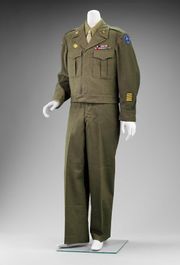Difference between revisions of "Drill (textile)"
Jump to navigation
Jump to search
| (2 intermediate revisions by 2 users not shown) | |||
| Line 1: | Line 1: | ||
| + | [[File:MFA2011193 Khaki.jpg|thumb|US Army uniform<br>MFA# 2011.193]] | ||
== Description == | == Description == | ||
| − | A strong, durable, twill-weave textile made of [[cotton]], [[linen]], or [[hemp]]. Drill fabric is used for work clothes, trousers, skirts, uniforms, outdoor furniture, awnings, and protective coverings for machinery. Tan-color drill is called khaki. | + | A strong, durable, twill-weave textile made of [[cotton]], [[linen]], or [[hemp]]. Drill fabric is used for work clothes, trousers, skirts, uniforms, outdoor furniture, awnings, and protective coverings for machinery. Tan-color drill is called [[khaki]]. |
== Synonyms and Related Terms == | == Synonyms and Related Terms == | ||
| Line 7: | Line 8: | ||
khaki; dril (Esp.); terliz (Esp.); dril (Ned); coutil (Fr); | khaki; dril (Esp.); terliz (Esp.); dril (Ned); coutil (Fr); | ||
| − | == | + | == Resources and Citations == |
* Hermann Kuhn, ''Conservation and Restoration of Works of Art and Antiquities'', Butterworths, London, 1986 | * Hermann Kuhn, ''Conservation and Restoration of Works of Art and Antiquities'', Butterworths, London, 1986 | ||
Latest revision as of 13:39, 23 October 2020
Description
A strong, durable, twill-weave textile made of Cotton, Linen, or Hemp. Drill fabric is used for work clothes, trousers, skirts, uniforms, outdoor furniture, awnings, and protective coverings for machinery. Tan-color drill is called Khaki.
Synonyms and Related Terms
khaki; dril (Esp.); terliz (Esp.); dril (Ned); coutil (Fr);
Resources and Citations
- Hermann Kuhn, Conservation and Restoration of Works of Art and Antiquities, Butterworths, London, 1986
- Matt Roberts, Don Etherington, Bookbinding and the Conservation of Books: a Dictionary of Descriptive Terminology, U.S. Government Printing Office, Washington DC, 1982
- Art and Architecture Thesaurus Online, http://www.getty.edu/research/tools/vocabulary/aat/, J. Paul Getty Trust, Los Angeles, 2000
- Edward Reich, Carlton J. Siegler, Consumer Goods: How to Know and Use Them, American Book Company, New York City, 1937
